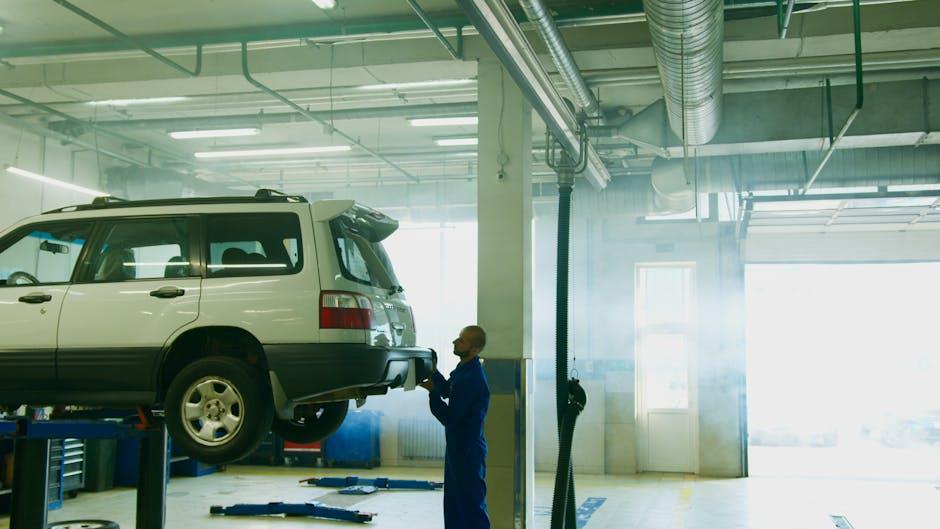When the summer heat blazes down or chilly winds creep in, a car’s air conditioning system is more than just a luxury—it’s a vital comfort lifeline. Yet, like any mechanical marvel, it’s prone to hiccups and breakdowns that can leave you sweltering behind the wheel. Understanding the common issues that plague car A/C systems, and knowing how to address them, can turn a stifling ride into a breeze. In this article, we’ll explore the typical problems drivers face with their car air conditioning and offer practical solutions to keep your cool no matter the season.
Table of Contents
- Understanding the Basics of Car Air Conditioning Systems
- Identifying Signs of a Malfunctioning AC
- Common Causes of Reduced Cooling Efficiency
- Diagnosing Refrigerant Leaks and Recharging Tips
- Addressing Electrical Issues and Faulty Components
- Preventive Maintenance to Keep Your AC Running Smoothly
- Q&A
- Concluding Remarks

Understanding the Basics of Car Air Conditioning Systems
At the core of every car’s cooling comfort lies a complex yet fascinating system designed to manage temperature and airflow seamlessly. The heart of the system is the compressor, which pressurizes the refrigerant and circulates it through a network of coils and valves. This refrigerant absorbs heat from the cabin air as it passes through the evaporator, transforming from a liquid to a gas in the process and leaving behind a cool breeze that makes driving in summer bearable. Essential components such as the condenser, receiver-drier, and expansion valve work in harmony to ensure the cycle runs efficiently, maintaining comfort no matter the weather outside.
There are a few key elements that can disrupt this delicate balance, often manifesting as poor cooling or strange noises. Common areas that require attention include:
- Refrigerant Levels: Low refrigerant is a frequent culprit behind weak cooling. Since it escapes through leaks, regular checks and refills are necessary.
- Compressor Functionality: A failing compressor can halt the refrigerant cycle entirely, causing the system to blow warm air.
- Electrical Components: Faulty fuses, relays, or switches can disrupt the system’s power supply, impacting airflow or temperature control.
| Component | Common Issue | Quick Fix |
|---|---|---|
| Compressor | Seizing or noise | Professional diagnosis & replacement |
| Refrigerant | Low pressure | Leak repair & recharge |
| Blower Motor | Weak airflow | Cleaning or motor replacement |

Identifying Signs of a Malfunctioning AC
One of the first clues that your car’s air conditioning system is not functioning properly comes from unusual sounds or smells. Strange noises like hissing, rattling, or grinding when the AC is turned on often indicate underlying mechanical issues or leaks. Likewise, a musty or moldy odor suggests the presence of clogged filters or stagnant moisture inside the system. Pay attention to how the air feels; if it’s not as cold as usual or if the airflow is weaker than normal, these are often early warning signs of trouble.
Besides sensory cues, certain physical symptoms can also hint at problems. These include:
- Visible condensation or water pooling inside or underneath the vehicle
- Inconsistent temperature regulation – fluctuating from cool to warm unexpectedly
- AC compressor clutch not engaging when switched on
| Symptom | Possible Cause | Immediate Action |
|---|---|---|
| Warm air blowing | Low refrigerant level | Check for leaks; recharge system |
| Strange noise | Compressor or fan issue | Inspect and repair components |
| Water accumulation | Clogged drainage system | Clear drain or condensate tubes |

Common Causes of Reduced Cooling Efficiency
When your car’s air conditioning system starts to lose its chill, several common culprits might be at play. One frequent issue is a leak in the refrigerant lines, which diminishes the cooling power by allowing the essential coolant to escape. Over time, clogged or dirty air filters can also restrict airflow, making the system work harder yet deliver less cold air. Additionally, a malfunctioning compressor — the heart of the AC system — can severely impact cooling efficiency, leading to inconsistent or weak airflow.
Other elements contributing to a decline in cool air delivery include faulty electrical components such as sensors and switches, as well as damaged condenser coils that struggle to dissipate heat effectively. These issues often show up in combination, creating a gradually worsening AC performance that requires prompt attention. To help visualize common causes, consider the table below:
| Cause | Effect on Cooling | Common Signs |
|---|---|---|
| Refrigerant Leak | Loss of cooling power | Weak airflow, warm air |
| Dirty Air Filters | Restricted airflow | Reduced air volume, musty smell |
| Compressor Failure | Inconsistent or no cooling | AC clutch not engaging, strange noises |
| Faulty Sensors | System misreads temperature | AC cycles on/off frequently |
| Damaged Condenser Coils | Inefficient heat dissipation | Heating under the hood, poor cooling |

Diagnosing Refrigerant Leaks and Recharging Tips
Spotting a refrigerant leak early can save you from expensive repairs and discomfort during hot months. Common signs include reduced cooling efficiency, hissing noises near AC lines, or frost buildup on pipes. Using a UV dye or electronic leak detector can pinpoint the exact location, especially in hard-to-reach areas. Remember, a low refrigerant level doesn’t just cause poor cooling—it can also damage your compressor, leading to more costly issues down the line.
When it comes to recharging your car’s AC system, precision is key. Overcharging can harm the compressor, while undercharging means your AC won’t perform optimally. Always use a refrigerant specified by the vehicle manufacturer and follow proper safety measures. Here’s a quick reference table for common refrigerant charge tips:
| Step | Tip |
|---|---|
| Preparation | Warm engine to operating temperature |
| Measurement | Use a gauge set for accurate pressure readings |
| Charging | Inject refrigerant slowly, monitoring pressure |
| Post-charge | Check cooling performance before closing hood |
- Always wear protective gloves and eyewear.
- Perform the recharge in a well-ventilated area.
- If in doubt, consult a professional technician.

Addressing Electrical Issues and Faulty Components
Electrical malfunctions and worn-out parts are often sneaky culprits behind the sudden failure of car air conditioning systems. When the compressor clutch refuses to engage or the blower fan stops spinning, it’s usually a signal that electrical components such as fuses, relays, or wiring harnesses may have issues. A quick diagnostic approach includes checking the fuse box for any blown fuses, inspecting wiring for corrosion or breaks, and testing relays that control the system’s power flow. Faulty sensors or switches can also disrupt the precise operation necessary for optimal cooling performance.
Common electrical issues to consider include:
- Blown fuses or faulty relays
- Damaged wiring or loose connections
- Defective pressure sensors or thermistors
- Malfunctioning control modules or switches
To simplify troubleshooting, here is a quick reference table outlining symptoms, possible causes, and recommended actions:
| Symptom | Possible Cause | Recommended Solution |
|---|---|---|
| Compressor not activating | Blown fuse or relay failure | Check and replace fuses/relays |
| Blower fan runs intermittently | Loose wiring or faulty switch | Inspect wiring; replace switch if needed |
| Inconsistent cooling | Defective pressure sensor | Test sensor and replace if faulty |
| No response from control panel | Malfunctioning control module | Diagnose electronics; repair or replace module |
Addressing these electrical and component-level issues not only restores the system’s functionality but also prevents further damage, saving costly repairs down the line.

Preventive Maintenance to Keep Your AC Running Smoothly
Regular upkeep of your car’s air conditioning system is essential in avoiding unexpected breakdowns and costly repairs. Simple tasks like checking and replacing the cabin air filter, inspecting refrigerant levels, and ensuring all electrical connections are secure can dramatically extend the life of your AC unit. Additionally, keep an eye out for odd noises or inconsistent cooling, as these early warning signs point to issues that can be resolved quickly when caught early.
To maintain optimal performance, consider this preventive maintenance checklist:
- Clean or replace filters: Prevent dust buildup that restricts airflow.
- Check refrigerant levels: Low levels reduce cooling efficiency.
- Inspect belts and hoses: Look for cracks or signs of wear.
- Test compressor function: Ensure it activates properly without strange sounds.
- Examine electrical components: Avoid shorts or loose wiring connections.
| Maintenance Task | Recommended Frequency | Benefit |
|---|---|---|
| Filter Replacement | Every 12,000 miles or annually | Improves air quality and airflow |
| Refrigerant Check | Every 2 years or as needed | Maintains cooling efficiency |
| Belt & Hose Inspection | Every 24,000 miles | Prevents unexpected breakdowns |
Q&A
Q&A: Common Car Air Conditioning Problems and Solutions
Q1: Why is my car’s air conditioning blowing warm air instead of cold?
A: When your AC blows warm air, it usually signals a refrigerant issue—either a leak or simply low levels. The refrigerant is the lifeblood of your AC system, enabling it to cool the cabin. A leak might mean you need a professional to inspect, repair, and recharge the system. Sometimes, clogged filters or a failing compressor can also cause warm air output.
Q2: What causes a strange smell when I turn on the car’s AC?
A: That funky odor often comes from mold and mildew thriving in the damp evaporator coils or air ducts. Over time, moisture accumulates and creates a breeding ground for bacteria. A quick solution is to run the defrost setting occasionally or use an AC disinfectant spray. Regular cabin air filter changes help keep the smell at bay.
Q3: Why does the air conditioning make loud noises while running?
A: Loud noises can hint at several underlying issues: a worn-out compressor clutch, loose belts, or debris caught in the blower fan. Sometimes, a failing condenser fan or damaged motor bearings cause grinding or rattling sounds. It’s best to have a technician diagnose this to avoid further damage.
Q4: What should I do if my AC only works intermittently?
A: Intermittent AC performance is often linked to electrical problems, like faulty wiring, a bad relay, or a failing pressure switch. The system might shut off to prevent damage. Checking the fuses and connections is a good start, but professional diagnostics ensure pinpoint accuracy.
Q5: How can I maintain my car’s air conditioning system to avoid these problems?
A: Preventative care is key! Regularly replace the cabin air filter, have your AC system inspected yearly, and run the AC for at least 10 minutes once a week—even in winter—to keep parts lubricated. Address minor issues promptly to prevent costly repairs down the road.
Q6: When is it time to replace my car’s AC compressor?
A: The compressor is the heart of your air conditioning. Signs it needs replacement include a squealing noise, failure to engage, or visible damage. If recharging refrigerant or minor repairs don’t restore cooling, a new compressor might be necessary—though it’s typically a more expensive fix.
Q7: Can I recharge my car’s AC system myself?
A: While DIY recharge kits exist, they’re best for topping off already healthy systems. Improper handling of refrigerant can be harmful and illegal in some regions. It’s safer and often more effective to have a professional handle the recharge, especially when diagnosing leaks or other issues.
This Q&A gives drivers a creative yet clear roadmap through the maze of common car AC problems, empowering them with knowledge and practical advice.
Concluding Remarks
In the ebb and flow of every journey, a well-functioning car air conditioning system transforms ordinary drives into refreshing escapes. While common issues like leaks, blower malfunctions, or refrigerant woes may disrupt that cool comfort, understanding their telltale signs and solutions empowers you to take the wheel with confidence. By staying attentive to these common problems, you can ensure that your car remains a sanctuary from the heat, no matter where the road leads. After all, a little care and know-how go a long way in keeping your cool on the go.


2 Comments
snt51e
snt51e